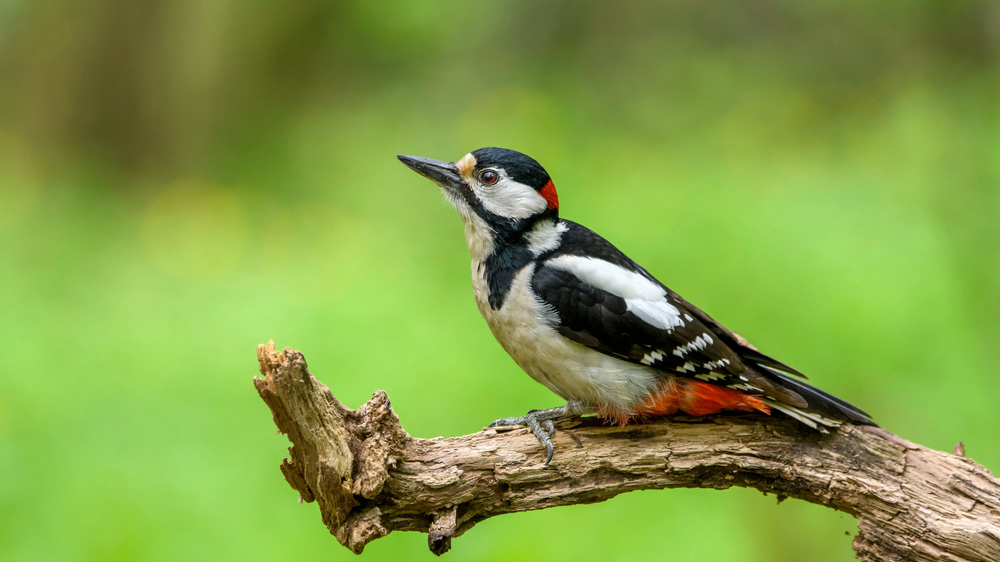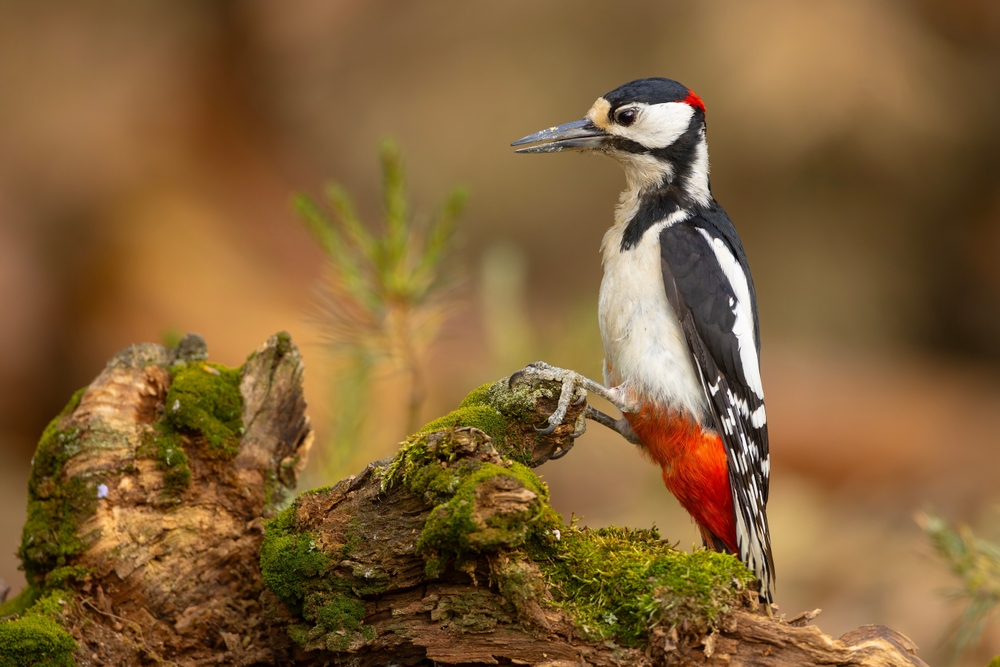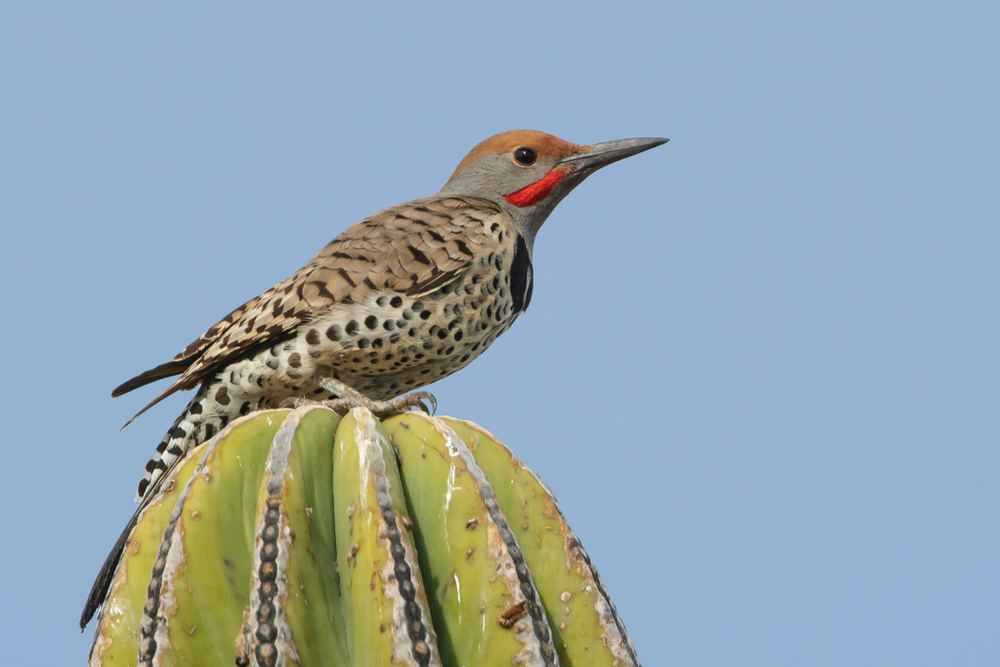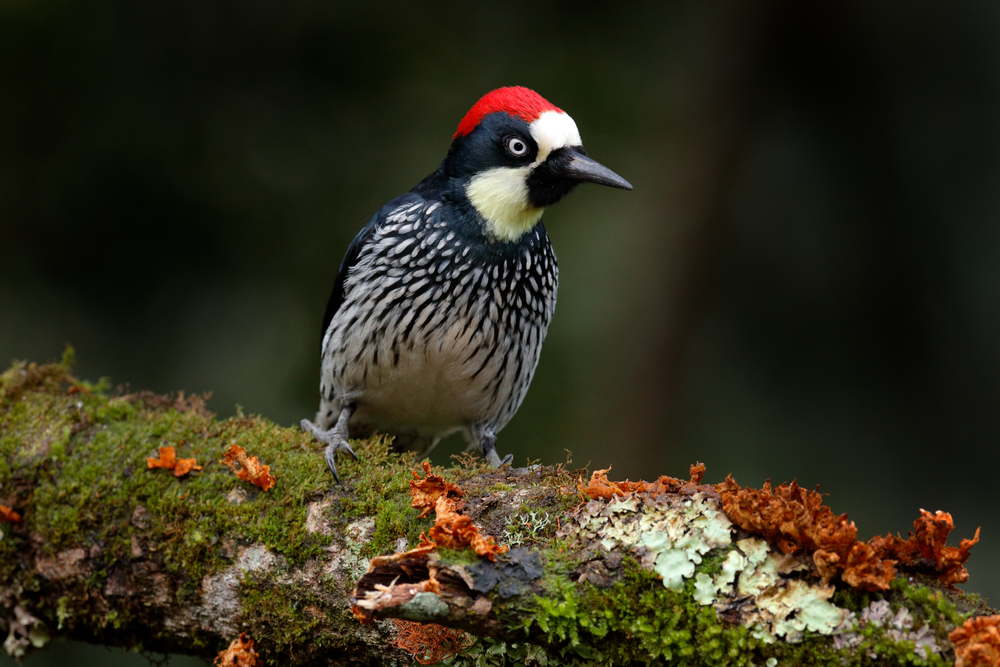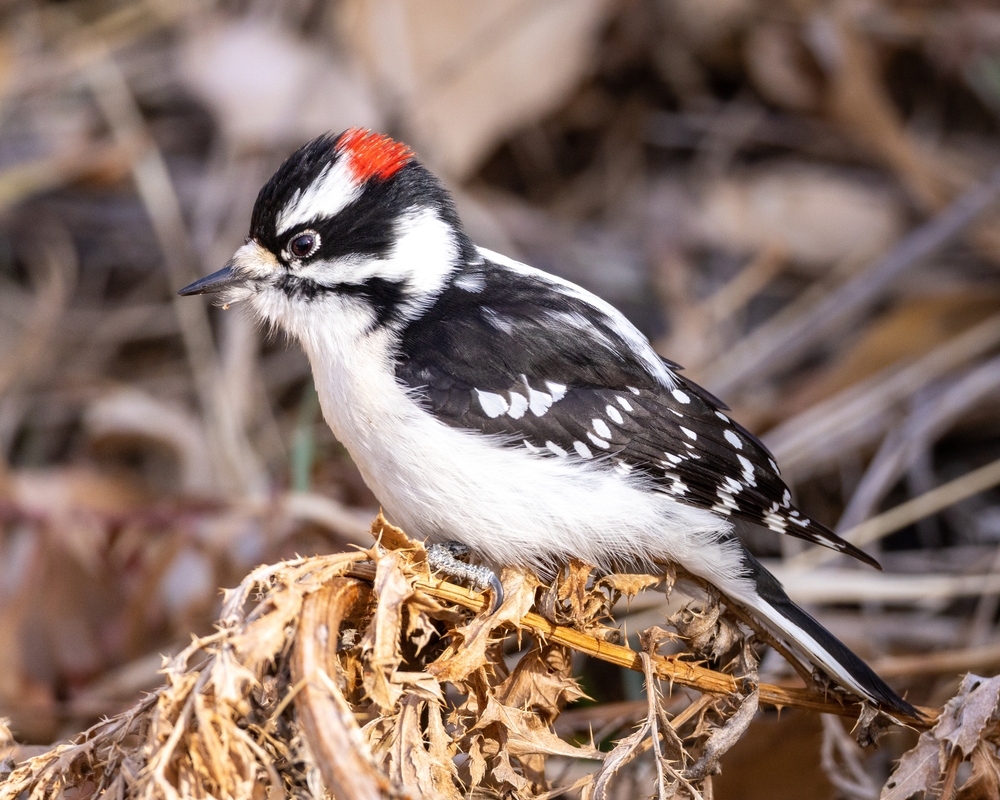The Great Spotted Woodpecker (Dendrocopos major) is closely related to other spotted woodpeckers in the genus Dendrocopos, particularly the Syrian Woodpecker (D. syriacus), which looks very similar but lacks the black cheek stripe.
About
The Great Spotted Woodpecker (Dendrocopos major), a member of the Picidae family, is one of the most widespread and familiar woodpeckers across Europe and Asia. Found in forests, woodlands, parks, and gardens, this adaptable bird is easily recognized by its bold black, white, and red plumage and its loud drumming calls that echo through wooded landscapes.
Measuring 23–26 cm (9–10 in) in length with a wingspan of 38–44 cm (15–17 in), the Great Spotted Woodpecker has a striking appearance. Its black upperparts are contrasted by a white shoulder patch, while the underparts are pale buff. Both sexes have a vivid red patch under the tail, but males also display a red patch on the nape, which females lack. Juveniles are marked by a red crown. Its strong bill and stiff tail feathers allow it to cling to tree trunks and excavate wood efficiently.
The diet of this woodpecker is diverse. Insects and their larvae form the bulk of its food during spring and summer, while in autumn and winter it feeds on nuts, seeds, and tree sap. It is well known for hammering open pine cones to extract seeds and occasionally raids nests of small birds for eggs or chicks. In human-altered environments, it will also visit bird feeders for peanuts and suet.
Breeding occurs in tree cavities excavated by the pair, usually in dead or decaying trees. The female lays 4–7 eggs, with both parents sharing incubation and feeding duties. Young fledge after about three weeks. Their loud drumming, produced by rapid bill strikes against wood, serves as a territorial and courtship display.
Widespread and common, the Great Spotted Woodpecker is classified as Least Concern. Its adaptability to natural forests and urban habitats alike ensures its continuing success as one of Europe and Asia’s most iconic woodland birds.
Physical Characteristics
The Great Spotted Woodpecker is a medium-sized, strikingly patterned woodpecker widely found across Europe and Asia:
Head and Face:
They have a black crown and nape with a bold white patch on each side of the face. Males are distinguished by a bright red patch on the back of the head, which females lack. Juveniles have a red crown instead.
Beak:
Their beak is straight, chisel-shaped, and grayish-black, designed for hammering into bark and drilling nest holes.
Plumage:
The back and wings are black, marked with prominent white shoulder patches and white wing bars. Underparts are pale buff to white. The undertail coverts are bright crimson red, giving the bird a distinctive flash of color in flight.
Body and Build:
They are sturdy birds with stiff tail feathers that provide support against tree trunks and zygodactyl feet (two toes forward, two backward) for a strong grip.
Size:
-
Length: 8.7 to 9.8 in (22 to 25 cm)
-
Wingspan: 13.8 to 17 in (35 to 44 cm)
-
Weight: 2.6 to 3.9 oz (75 to 110 g)
The Great Spotted Woodpecker’s bold black, white, and red plumage, combined with its strong drumming and widespread presence, makes it one of the most easily recognized woodpeckers of Eurasia.
Reproduction
The reproductive cycle of the Great Spotted Woodpecker is typical of cavity-nesting woodpeckers, with both parents sharing responsibilities:
1. Courtship and Pair Formation:
Courtship occurs in early spring and includes drumming displays, calling, and chasing. Once paired, they are generally monogamous for the breeding season.
2. Breeding Season:
Breeding usually takes place from April to June, with timing influenced by climate and food availability.
3. Nesting:
Pairs excavate nest cavities in dead or decaying trees, though sometimes in living trees with softer wood. Cavities are usually 10 to 20 in (25 to 50 cm) deep, with wood chips forming the nest lining.
4. Egg Laying:
The female lays 4 to 6 glossy white eggs. Both parents take turns incubating.
5. Incubation:
Incubation lasts 10 to 12 days, with males often handling night shifts and females during the day.
6. Chick Development:
Chicks hatch naked and blind, fully dependent on their parents. They are fed a diet of insects and larvae brought directly to the nest cavity.
7. Fledging and Independence:
The young fledge at about 20 to 24 days of age but may continue to be fed by their parents for up to two weeks after leaving the nest.
The Great Spotted Woodpecker’s excavation skills and cooperative parenting ensure strong chick survival, making it one of the most successful and widespread woodpeckers across Eurasia.
Lifespan
The Great Spotted Woodpecker is a moderately long-lived bird, with survival influenced by habitat quality and food supply.
Lifespan in the Wild:
In their natural forested habitats, Great Spotted Woodpeckers typically live 5 to 10 years, though the average life expectancy is closer to 2 to 3 years due to high juvenile mortality. The longest recorded lifespan in the wild is over 11 years.
Lifespan in Captivity:
When cared for with steady food and protection from predators, individuals can live longer, sometimes reaching 12 to 15 years in managed conditions.
Threats to the Great Spotted Woodpecker:
-
Predation: Eggs and chicks are preyed upon by martens, squirrels, snakes, and larger birds such as jays and owls.
-
Habitat Loss: Removal of mature trees and deadwood reduces nesting and foraging sites.
-
Competition: They compete with starlings and other cavity-nesting birds for nest sites.
-
Climate Factors: Harsh winters or poor insect years reduce survival, particularly among juveniles.
Despite these pressures, the Great Spotted Woodpecker’s adaptability to forests, orchards, parks, and gardens helps maintain strong populations across Europe and Asia.
Eating Habits
The Great Spotted Woodpecker has a varied diet and flexible feeding habits that allow it to thrive in forests, parks, and gardens:
Diet:
They feed primarily on insects and larvae, especially wood-boring beetles, ants, and caterpillars. In autumn and winter, their diet expands to include seeds, nuts (particularly pine cones), berries, and tree sap. They will also raid nests for eggs and chicks of smaller birds.
Feeding Strategy:
They forage by hammering and probing into tree bark to extract insects, often leaving characteristic rectangular holes. In winter, they wedge pine cones into crevices or “anvils” in trees to hammer them open for seeds.
Role in Ecosystem:
By preying on wood-boring insects and larvae, they help control pest populations. Their cone “anvils” also provide food opportunities for other species once abandoned.
Social Feeding Behavior:
Great Spotted Woodpeckers are mostly solitary feeders, though pairs may forage in the same area during breeding season. In winter, they are more secretive but occasionally visit bird feeders for suet, peanuts, and sunflower seeds.
Feeding Technique:
They use their strong beak to chisel into wood and a long, barbed tongue coated with sticky saliva to extract insects from crevices. They also drink sap by pecking holes into trees, similar to sapsuckers.
The Great Spotted Woodpecker’s adaptability in diet and foraging techniques allows it to exploit food sources year-round, making it one of the most successful and widespread woodpeckers across Eurasia.
Uniqueness
The Great Spotted Woodpecker (Dendrocopos major) is one of Europe and Asia’s most familiar and adaptable woodpeckers, with several traits that distinguish it from other species:
Striking Plumage:
Its bold black-and-white plumage with bright red undertail coverts and the male’s red nape patch make it one of the most recognizable birds in its range.
Versatile Forager:
Unlike many woodpeckers that specialize in insects, the Great Spotted Woodpecker has a highly varied diet that includes insects, seeds, nuts, sap, and even eggs and nestlings, giving it year-round survival flexibility.
Cone “Anvils”:
They are known for wedging pine cones into cracks in trees to hammer them open for seeds, leaving behind “anvils” that mark their feeding sites.
Adaptability:
They thrive in diverse habitats, from dense forests to urban parks and gardens, and are among the few woodpeckers commonly seen at bird feeders in Europe.
Powerful Drumming:
Their rapid drumming on trees and wooden surfaces serves as a territorial and courtship signal, making them one of the most vocal members of their genus.
Expanding Range:
The species has steadily expanded across Europe, and even into areas with extensive human activity, showing remarkable resilience.
The Great Spotted Woodpecker’s bold appearance, adaptability, and resourceful feeding behaviors make it one of the most successful and iconic woodpeckers of Eurasia.
Be the First to Share Photos of This Species.
FAQ’s
1. What species is closest to the Great Spotted Woodpecker?
2. How does the Great Spotted Woodpecker compare to other woodpeckers?
It is larger than the Downy and Middle Spotted Woodpeckers but smaller than the Green and Black Woodpeckers. Unlike many species, it has a highly varied diet, feeding on insects, seeds, sap, and even bird eggs. Its use of cone “anvils” to crack seeds is also distinctive.
3. What national parks provide the best opportunity to see a Great Spotted Woodpecker?
The Great Spotted Woodpecker is widespread across Europe and Asia. Some of the best parks to see them include:
-
Białowieża Forest, Poland/Belarus
-
Plitvice Lakes National Park, Croatia
-
Triglav National Park, Slovenia
-
Khingan Nature Reserve, Russia
-
Lake District National Park, UK
These mature forests and mixed woodlands provide ideal habitats for observing this species’ drumming and foraging behavior.



































































